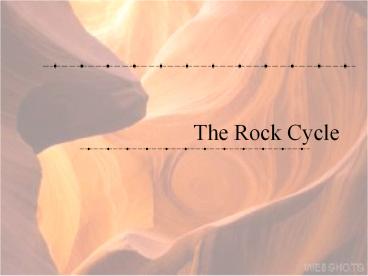The Rock Cycle - PowerPoint PPT Presentation
1 / 22
Title:
The Rock Cycle
Description:
The Rock Cycle What is the Rock Cycle? The idea that rocks are continually changing from one type of rock to another through Earth s natural processes. – PowerPoint PPT presentation
Number of Views:186
Avg rating:3.0/5.0
Title: The Rock Cycle
1
The Rock Cycle
2
What is the Rock Cycle?
- The idea that rocks are continually changing from
one type of rock to another through Earths
natural processes.
Are any of these rocks being created or destroyed
throughout the processes of the rock cycle?
3
Key Words to Understanding the Rock Cycle
- Igneous Metamorphic Sedimentary
- Intrusive Extrusive Magma Lava
- Cooling Melting Crystallization (Crystal
Size) - Heat Pressure Weathering
Erosion - Sediment Compacting Cementing
Deposition
4
Igneous Rock
5
Igneous Rock
- Igneous rock is formed when magma or lava cools
and crystallizes - INtrusive when magma cools INside
- cools slower larger crystals
- EXtrusive when lava cools OUTside
- cools faster smaller crystals
What is the difference between lava and magma?
6
Metamorphic Rock
7
Metamorphic Rock
- Metamorphic rock forms from heat pressure
- Metamorphic means to change form represents a
chemical change - Usually forms deep in Earths crust BUT it can
form anywhere there is a lot of heat pressure
Where could these regions of heat or pressure
occur?
8
Sedimentary Rock
9
Sedimentary Rock
- Sedimentary rock is formed by layers of sediment
being pressed together over time. - Erosion and weathering near Earths surface
- Sediments are transported from one place to
another deposited in layers with the oldest
sediment on the bottom - The layers become compacted and cemented together
What could these sediments be composed of?
10
Extra Vocabulary Help
- Please read through the next slides if you need
clarification on any of the vocabulary presented
in this lesson! - Slides 16-18 Igneous Vocab
- Slide 19 Metamorphic Vocab
- Slides 20-27 Sedimentary Vocab
11
Melting Cooling
- Melting is the result of continued heating
- Leads to production of magma or lava and new
igneous rocks which are formed when the the magma
or lava cools. - Cooling leads to the magma or lava forming a
solid igneous rock. - Magma is molten rock that is still inside of
Earth - Lava is molten rock that is on Earths surface
12
Crystallization
- When the magma or lava gets cool enough the
minerals that will make up the rock begin to
crystallize and form an intergrown mass of
crystals. - If the crystals begin to form deep in the Earth
where it is relatively warm the magma cools
slowly allowing the crystals to grow relatively
large. - If the magma reaches the surface, the lava cools
quickly and the crystals do not have time to grow
very large. - If the crystals cannot grow at all and volcanic
glass is formed. - This is what causes intrusive or extrusive
igneous rocks
13
Crystallization
14
Heat and Pressure
- Metamorphic rocks trapped underground are still
subject to enormous heat from rising magma, or
heated water, and pressure. Sometimes the heat
can get so intense the rocks actually melt, but
often the change occurs when the rock is still a
solid! - Pressure comes from the incredible weight of
material surrounding the rock on all sides. Or,
for example millions of years of sediment on top
of each other. - The pressure pushes new minerals into the rock
and drives other minerals out the result, of
course, is that the rock is chemically changed.
15
Sediment
- Examples of sediment can be pretty much anything
like - Materials, originally suspended in a liquid,
(usually water) that settles at the bottom of the
liquid when it is left standing for a long time
stream beds, mouth of rivers etc - Material eroded from preexisting rocks that is
transported by water, wind, or ice and deposited
elsewhere - Organic material such as fossil fragments,
shells, seeds, bones etc.
16
Sediment
17
Weathering
- The process in which rocks are broken down by
chemical and/or physical processes into smaller
particles. - There are three types of weathering
- Physical Weathering physical action which breaks
up rocks. An example of this is freezing
thawing of water trapped in the cracks or pores
of rocks. - Chemical Weathering When the rock is attacked by
chemicals. An example of this is how acid rain
breaks down limestone. - Biological Weathering Occurs when rocks are
weakened and broken down by animals and plants. A
tree root system that is slowly splitting rocks
is an example of this type of weathering.
18
Erosion
- Erosion is the wearing away, or mass wasting of
exposed surfaces by natural forces such as wind,
moving water and ice. Rock fall under gravity is
also erosion. - This is the removal process that follows
weathering.
19
Erosion
20
Compaction
- The result of this pressure is a compaction of
the sediment - The sediment is squeezed or compacted together
causing a reduction in pore space and a sticking
together of the grains. - The pressure is often a result of the layers of
sediment on top pressing down on older layers.
21
Cementation taking Compaction a step further
- Most sediments are deposited in water containing
dissolved minerals. - The water flows through the sediment and some of
these minerals precipitate on the grain surfaces.
- With time, the liquid material effectively glues
the sediment together into a cohesive solid - a
sedimentary rock.
22
Deposition Transportation
- The transportation process occurs when the
particles created by weathering are carried or
moved by ice, air, or water to a different
location. - The sediment is then deposited or laid to rest in
that new location.































